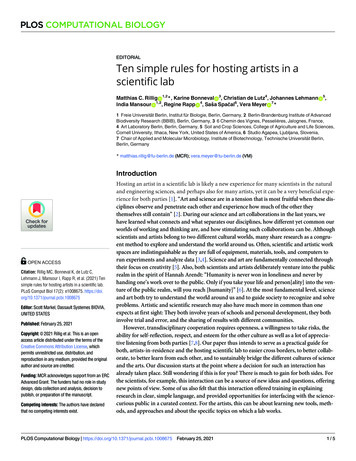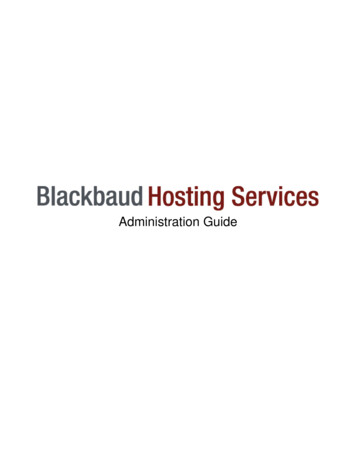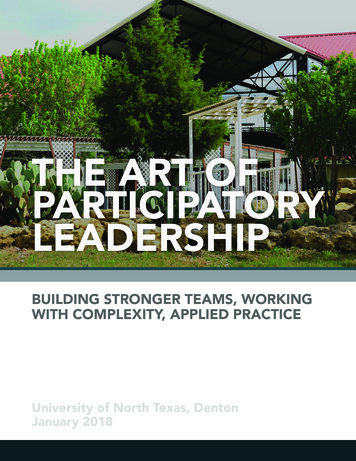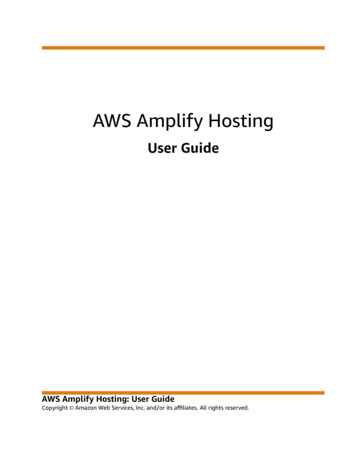
Transcription
PLOS COMPUTATIONAL BIOLOGYEDITORIALTen simple rules for hosting artists in ascientific labMatthias C. Rillig ID1,2*, Karine Bonneval ID3, Christian de Lutz4, Johannes Lehmann ID5,India Mansour ID1,2, Regine Rapp ID4, Saša Spačal6, Vera Meyer ID7*1 Freie Universität Berlin, Institut für Biologie, Berlin, Germany, 2 Berlin-Brandenburg Institute of AdvancedBiodiversity Research (BBIB), Berlin, Germany, 3 6 Chemin des Vignes, Pesselières, Jalognes, France,4 Art Laboratory Berlin, Berlin, Germany, 5 Soil and Crop Sciences, College of Agriculture and Life Sciences,Cornell University, Ithaca, New York, United States of America, 6 Studio Agapea, Ljubljana, Slovenia,7 Chair of Applied and Molecular Microbiology, Institute of Biotechnology, Technische Universität Berlin,Berlin, Germany* matthias.rillig@fu-berlin.de (MCR); vera.meyer@tu-berlin.de 1111111111a1111111111OPEN ACCESSCitation: Rillig MC, Bonneval K, de Lutz C,Lehmann J, Mansour I, Rapp R, et al. (2021) Tensimple rules for hosting artists in a scientific lab.PLoS Comput Biol 17(2): e1008675. : Scott Markel, Dassault Systemes BIOVIA,UNITED STATESPublished: February 25, 2021Copyright: 2021 Rillig et al. This is an openaccess article distributed under the terms of theCreative Commons Attribution License, whichpermits unrestricted use, distribution, andreproduction in any medium, provided the originalauthor and source are credited.Funding: MCR acknowledges support from an ERCAdvanced Grant. The funders had no role in studydesign, data collection and analysis, decision topublish, or preparation of the manuscript.Competing interests: The authors have declaredthat no competing interests exist.Hosting an artist in a scientific lab is likely a new experience for many scientists in the naturaland engineering sciences, and perhaps also for many artists, yet it can be a very beneficial experience for both parties [1]. “Art and science are in a tension that is most fruitful when these disciplines observe and penetrate each other and experience how much of the other theythemselves still contain” [2]. During our science and art collaborations in the last years, wehave learned what connects and what separates our disciplines, how different yet common ourworlds of working and thinking are, and how stimulating such collaborations can be. Althoughscientists and artists belong to two different cultural worlds, many share research as a congruent method to explore and understand the world around us. Often, scientific and artistic workspaces are indistinguishable as they are full of equipment, materials, tools, and computers torun experiments and analyze data [3,4]. Science and art are fundamentally connected throughtheir focus on creativity [5]. Also, both scientists and artists deliberately venture into the publicrealm in the spirit of Hannah Arendt: “Humanity is never won in loneliness and never byhanding one’s work over to the public. Only if you take your life and person[ality] into the venture of the public realm, will you reach [humanity]” [6]. At the most fundamental level, scienceand art both try to understand the world around us and to guide society to recognize and solveproblems. Artistic and scientific research may also have much more in common than oneexpects at first sight: They both involve years of schools and personal development, they bothinvolve trial and error, and the sharing of results with different communities.However, transdisciplinary cooperation requires openness, a willingness to take risks, theability for self-reflection, respect, and esteem for the other culture as well as a lot of appreciative listening from both parties [7,8]. Our paper thus intends to serve as a practical guide forboth, artists-in-residence and the hosting scientific lab to easier cross borders, to better collaborate, to better learn from each other, and to sustainably bridge the different cultures of scienceand the arts. Our discussion starts at the point where a decision for such an interaction hasalready taken place. Still wondering if this is for you? There is much to gain for both sides. Forthe scientists, for example, this interaction can be a source of new ideas and questions, offeringnew points of view. Some of us also felt that this interaction offered training in explainingresearch in clear, simple language, and provided opportunities for interfacing with the sciencecurious public in a curated context. For the artists, this can be about learning new tools, methods, and approaches and about the specific topics on which a lab works.PLOS Computational Biology https://doi.org/10.1371/journal.pcbi.1008675 February 25, 20211/5
PLOS COMPUTATIONAL BIOLOGYFig 1. Summary of the 10 rules, arrayed from intellectual/philosophical to practical/logistical and divided intorules more applicable to the hosting science lab and rules relevant for both the hosting lab and the 5.g001Some of the following 10 “rules” apply more to the artist, some more to the hosting sciencelab, and some to both (Fig 1).Rule 1: Be openThe basic mindset and attitude required for both scientists and artists is openness. Opennessto new input, willingness to share ideas, and a sharing attitude. It is not at all required to havean artistic “inclination” on the part of the hosting scientist, but nothing can replace an openattitude. Be open to accept that research can be both: scientific research and artistic research(for a definition of artistic research, see [9]).Rule 2: InviteScientists may actively approach and invite artists to join their labs for a specific period oftime. They should be aware that—although their own salaries are usually secured—the incomeof an artist is not secured. Hence, make sure to have a grant available that should cover theincome of the artist and consumables for his or her artistic research.Thus, seek out and visit art residencies and their show openings; make studio visits. Browsethe internet and visit gallery shows and contact artists directly or get in touch with organizations that connect artists with scientists. Such organizations vary according to country andregion. Some scientific organizations (e.g., CERN) have their own associated partners. In theEU, a number of organizations promote and support artists. Many of these have experiencearranging collaborations: Examples are The Waag Society (NL), Kersnikova/Kapelica (SLO),BioArt Society (FI), Cultivamos Cultura and Ectopia (PT), Art Laboratory Berlin, and ScheringStiftung (D). Universities in many countries also support collaborations, and some have internal organizations that do so, for example, Metaphorest at Waseda University, Tokyo, SymbioticA at the University of Western Australia, and the MIT Media Lab.Keep your lab’s websites up to date. Consider working with the artist when developing proposals for funding; this will ensure that sufficient funds are available and that the proposal ispitched in a way that works for the artist, but it will likely also be a much better proposal withmuch greater chance of funding the full project if it has a compelling broader impact module(if this is required for your national funding agency).PLOS Computational Biology https://doi.org/10.1371/journal.pcbi.1008675 February 25, 20212/5
PLOS COMPUTATIONAL BIOLOGYRule 3: Accept artists as researchersAn artist is not primarily in a scientific lab to perform outreach activities for lab’s research orillustrate and communicate scientific research results, even though this can also be an outcome. The artist is a researcher in the arts. Remember, while “the means” or the process maybe the same, and the goals may also include to arrive at new insights, the product may takemany different forms. The artist is doing research to produce an artwork, even if it may takethe shape of sound art, a performance, or ephemeral objects. Some examples from our artistcoauthors may help illustrate this point. Karine Bonneval researches the acoustic world surrounding plants. Her artworks bridge our perception and understanding of what plants areand how they create ecologies (https://www.karinebonneval.com/). Saša Spačal’s research andinstallations create spaces for exploring symbiosis between life forms, often involving humaninteraction (https://www.agapea.si/en/).Rule 4: Recognize the conceptScientists should not equate art projects with producing a painting to hang on the wall. Do notanticipate that an object will be created (even if in many or most cases it may be so). Focus onthe concept, and allow the concept to be either directly related to the natural science/engineering research or also and specifically to creative practice (how do I develop an idea or a question?) as well as to sociopolitical dimensions.Rule 5: IntegrateThe more effortlessly artists can become integrated in the scientific lab group and its routines,the better. For example, they could come to regular lab meetings, even give presentationsthere, or else participate in the technical discussions (certain topics are more appropriate thanothers). Ensure that the artist becomes embedded with his or her own place in the lab. Consider offering a lab tour to the artist at the beginning of the residency. All of this will make theartists more well-known in the lab group, and this is very important for the success of the artist’s residence, as it increases the number of potential interactions. Be open to learn as much aspossible from the artist or the artistic practice in your science project as vice versa.Rule 6: Find common languageDifferent disciplines and surely artists and scientists use different languages. To understandeach other, use or develop common language: explain terminology, both physical (what is asoil aggregate?) as well as conceptual (what does creativity mean?). Be aware that this processis probably the most time-consuming part of this joint endeavor. Even the same words canhave different meanings, potentially leading to misunderstanding. Hence, sometimes, severalrounds of explanation may be necessary to find a common language.Rule 7: Be curious about and understand each other’s holismMost scientists in life sciences and engineering use holistic approaches to study, understand,and design (a)biotic systems. The biology of (micro)organisms are studied from the community, cellular, molecular, and physical levels with technologies and tools developed, e.g., inchemistry, biotechnology, computer, and material sciences. Hence, inter- and transdisciplinarity is a central working method for many scientists.Artistic research often bridges different scientific disciplines with cutting-edge theory fromthe humanities (philosophy, cultural studies, ethics, and aesthetics) and social sciences (sociology and anthropology) creating both larger audiences and exchange of ideas across fields onPLOS Computational Biology https://doi.org/10.1371/journal.pcbi.1008675 February 25, 20213/5
PLOS COMPUTATIONAL BIOLOGYtopics such as the “anthropocene,” diversity loss, and antibiotic resistance, as well as questioning cultural viewpoints on the supposed divide between nature and (human) culture.For both parties, it is helpful to be explicit about the other fields they draw upon in theirwork, making clear the respective “network of ideas” at play. This also requires awareness ofour own intellectual context that we might normally take for granted when staying within ourown respective “spheres” of science or the arts.Rule 8: Know the otherInteractions are effortless when the artist and scientist can communicate effectively and whenthe artist knows some background of the work done in the lab. Websites of many scientificgroups introduce their scientific visions, approaches, technologies, and achievements. Scientific publications offer in-depth details and are often inspirational for artists. The more prepared artists are in knowledge and practice, the easier (and more successful) the residency willbe.Similarly, the scientist must not only know the media and oeuvre that the artist is workingin, but also the progression and trajectory of concepts and questions. Familiarize yourself withthe evolution of the artists thinking through the artists’ website, which is inspirational, too.Rule 9: Be mindful of time constraints on both sidesScientists are typically busy with the day-to-day craziness of managing a lab, writing grants,and papers, so it is important to be mindful of these constraints and to fit into their schedule.This is best achieved by scheduling meetings that fit the academic structure, such as a 45-minute meeting or shorter, with specific goals.Similarly, recognize that artists do not have unlimited time or may not be available whenthey are preparing shows or publications, writing grants, or are busy running their studios. Beflexible, when a meaningful interaction with artists is possible, and schedule meetings duringthose phases and days that provide opportunities to generate new insights.Rule 10: Enjoy the challengeMerging science and the arts in one lab is not an easy endeavor neither for the artist nor thescientist and the scientists’ group. Getting appropriate funding, struggling with the difficultiesin communication, and understanding of the different concepts and results is time-consuming, unpredictable, and uncontrollable (the latter can be a nightmare for some scientists).However, those who are willing to take on these challenges, who want to cooperate on eye levelwith the other, and who appreciate the other as companions will be rewarded with a tinglingbrain shower that can open new horizons in both artistic and scientific research. By joining scientific and artistic research, we could gain access to the wider complexity of a particular subject, inaccessible to one methodological approach alone.We believe that when both parties consider these rules, they will be better prepared for thechallenge, increasing the likelihood of a successful residency. With in-person residencies currently rendered challenging due to the pandemic, virtual (online) residencies are an optionand may also be a good way to get acquainted during non-pandemic times.References1.Rillig MC, Bonneval K. The artist who co-authored a paper and expanded my professional network.Nature. 2020 [cited 2020 Jul 17]. https://doi.org/10.1038/d41586-020-00575-7PLOS Computational Biology https://doi.org/10.1371/journal.pcbi.1008675 February 25, 20214/5
PLOS COMPUTATIONAL BIOLOGY2.Liessmann KP. Das Verhältnis von Wissenschaft und Kunst—science.ORF.at. In: Science at orfat[Internet]. 6 Nov 2013 [cited 2020 Oct 4]. Available from: l3.Bürkle S. Atelier Labor. Werkstätten des Wissens. Hatje Cantz Verlag; 2018. Available from: -labor-7395-0.html4.Meyer V. Merging science and art through fungi. Fungal Biol Biotechnol. 2019; 6:5. https://doi.org/10.1186/s40694-019-0068-7 PMID: 310578025.Lehmann J, Gaskins B. Learning scientific creativity from the arts. Palgrave Commun. 2019; .Arendt H. Men in dark times. New York, New York: Harcourt, Brace & World, Inc.; 1968.7.Johung J. Experiments in Art Soil: biochar, media technology, and a collaboration between NathanielStern and Johannes Lehmann. The World After Us: Imaging Techno-Aesthetic Futures. Wisconsin,USA: TAUW; 2020. p. 112–138.8.Meyer V, Rapp R. Mind the Fungi. Berlin: TU Verlag; 2020. https://doi.org/10.14279/depositonce103509.Klein J. What is artistic research? JAR. 2017 [cited 2020 Dec 12]. https://doi.org/10.22501/jarnet.0004PLOS Computational Biology https://doi.org/10.1371/journal.pcbi.1008675 February 25, 20215/5
EDITORIAL Ten simple rules for hosting artists in a scientific lab Matthias C. Rillig ID 1,2*, Karine Bonneval ID 3, Christian de Lutz4, Johannes Lehmann ID 5, India Mansour ID 1,2, Regine Rapp ID 4, Sasˇ a Spačal6, Vera Meyer ID 7* 1 Freie Universita t Berlin, Institut fu r Biologie, Berlin, Germany, 2 Berlin-Brandenburg Institute of Advanced Biodiversity Research (BBIB), Berlin, Germany .










